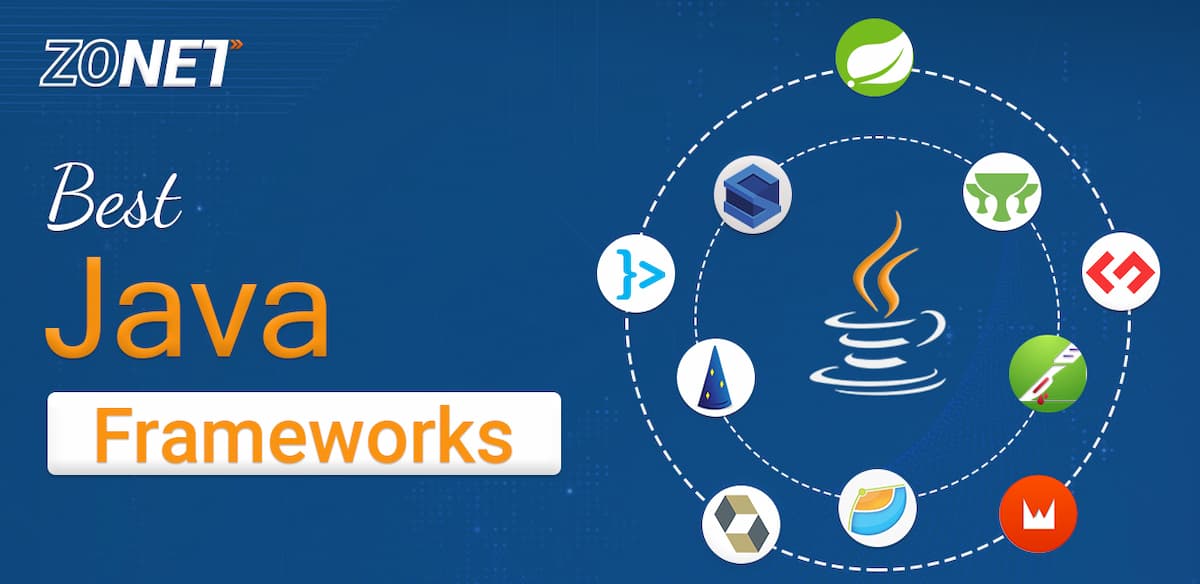Introduction
Several popular Java frameworks, such as Spring, Hibernate, and Struts, offer several profits. These offer prospects like reusability, efficiency, and scalability. These packages offer enormous libraries of pre-built components and best practices to complete the developmental process quickly and efficiently. The best framework according to the requirement of the project for the size and the features under consideration should be selected.
10 best JAVA Frameworks
Java frameworks support more comfortable software development with their systematic methods. The following ten must-know Java frameworks for rapid development are overviewed in this section, including Spring for enterprise apps, Hibernate for ORM, Apache Struts for web applications, Dropwizard and Quarkus for backend services, Grails and Play for productivity, and Vaadin for rich UIs. Take a closer look at how these tools can help optimize your projects.
Alpha Struts
Alpha Struts is an extended framework that was supposed to ease web development by offering a more robust yet flexible platform. It was built upon Apache Struts and further added several features to enhance performance, flexibility, and usability for the developer. It focuses on modularity and scalability in web application development to ensure handling even the most complex projects with ease.
FeaturesMVC Architecture: Applies the Model-View-Controller design pattern, separating data, user interface, and control logic from each other in such a way that contributes to well-organized code and will ease further maintenance and scalability.
Modularity: Provides for modular development where reusable components can be created and managed for independent integration into various parts of the application. This increases the speed of development and reusability of code.
Customizable: Most of the components and the configurations could be changed according to the requirements with little effort, hence making the integration of new functionalities easier.
Integration Support: Allows for easy integration with other Java technologies and frameworks. That in turn provides excellent support for the development of complex multi-tier applications, making it realizable to utilize the existing toolsets and libraries.
Full Documentation: Fully documented with resources that would make learning and using the features in the framework efficient, hence smoothing the learning curve.
Caching out of the Box: Caches data that is accessed repeatedly to improve performance, which reduces loads from back systems and makes for quicker responses.
Dropwizard
Dropwizard is a Java framework that makes it easy to build production-ready RESTful web services and applications. It assembles an integrated structure from libraries and tools already well-established in an easy-to-use package. It has a particular emphasis on performance, reliability, and the productivity of developers. It is well recognized that Dropwizard focuses on building production-ready applications with the least configuration and setup.
FeaturesComprehensive Framework: The basic libraries and other tools needed for such a framework are integrated, including Jersey for the RESTful services, Jackson for JSON processing, and Metrics for monitoring in one complete solution for web service creation.
Embedded Server: An embedded Jetty server allows the application to be self-contained and easily deployed without having to work out any external server setup.
Configuration Management: It uses YAML configuration files to simplify the setting up and maintenance of application settings. This supports various environments and hence simplifies deployment.
Monitoring and Metrics: It supports application performance monitoring out-of-the-box, using metrics, and allows the collection and visualization of key performance indicators.
Authentication and Security: It embeds various security features like HTTPS support and an authentication mechanism that ensures a secure channel for communication and access control.
Health Checks: It includes health check frameworks, which allow developers to define and implement checks to monitor the health status of different parts of the application to ensure reliability and assist in early fault detection.
Grails
Grails is a very powerful web application framework. It uses the Groovy programming language; thus, Grails provides an intuitive, high-productivity environment in which to build robust applications. On top of the Spring framework and using Hibernate for ORM, Grails emphasizes convention over configuration, hence accelerating the development and simplifying complex tasks.
FeaturesConvention over Configuration: It is a convention-based approach that reduces the amount of configuration a developer must do, basically letting the developer concentrate on writing the logic for his application instead of such trivial but many times repetitive and time-consuming work as writing boilerplate code.
Groovy Language: The Groovy programming language is used, which is much more expressive and concise compared with Java. So, since its syntax is more readable, its code can be created very fast and maintained with quite a lot of ease.
Integrated Development Environment: Embedded with a powerful integrated development environment that would contain the necessary tools for rapid application development, testing, and deployment, which means eliminating additional tooling when working with the programmable network.
Out-of-the-box ORM through GORM: By using GORM, or Grails Object-Relational Mapping, it provides a clean way to interact with databases that would otherwise easily complicate access and handling of data through an extremely powerful and flexible ORM layer.
Spring and Hibernate Integration: Integrates Spring and Hibernate for a robust core in enterprise applications by leveraging components of the Java ecosystem that already exist.
Scaffolding: It has automatic scaffolding for the quick creation of CRUD (Create, Read, Update, Delete) interfaces and code.
Hibernate
Hibernate is one of the well-known frameworks in the Java ecosystem, which is intended to make the life of a Java developer easy with relational databases. That works somewhat like a bridge, enabling the developer to interact in object-oriented ways with the database instead of dealing with complex SQL queries for data manipulation. Therefore, by default, Hibernate automates many records create, read, update, and delete activities reduces manual SQL coding along with errors, and accelerates development. It also manages database connections and transactions quite efficiently.
FeaturesObject-Relational Mapping: Hibernate automatically converts your Java objects to database tables and vice-versa, which allows you to operate with Java objects without having to deal with SQL queries or database-specific details.
Table Generation: By default, Hibernate can build tables in your database from the Java classes that you define. This greatly simplifies the administration of database schema and reduces the amount of manual SQL scripts.
Transaction Management: Well-integrated with several transaction management strategies to ensure the consistency and integrity of the data due to multiple database operations.
Caching Hibernate provides different kinds of caching mechanisms to improve performance. There is a first-level cache, which is the session cache. Also, second-level caching is provided, which allows frequently accessed data to be stored in a cache to reduce database queries.
HQL: Besides writing raw SQL, HQL is an object-oriented query language of higher abstraction, which will make your queries more intuitive and easier to understand.
Lazy Loading: Through Hibernate, lazy loading is supported where the related data is loaded only when it is required; thus, enhancing performance since unnecessary retrieval of data is avoided.
JHipster
JHipster is a modern development platform that with ease simplifies the generation of modern web applications and microservices by combining several popular frameworks and tools. As such, it simplifies the developer's work in creating both the frontend and backend parts. The automation of the repetitive setup tasks saves developers from spending too much time with the so-called 'configuration details' and they can develop the business logic. It's a well-known code generator that provides the basis for your application to be scalable and maintainable. It is flexible enough to support several technologies and architectures, from small web applications down to complex microservices.
FeaturesDevelopment Tools: The major development tools of JHipster include hot reloading, where you can instantly see your changes, and integrated testing frameworks that ensure high-quality, reliable code.
Customizability: High customizability in the generated code and configuration allows the developer to tune and extend the setup to the needs of the specific project.
Active Community and Support: The community around JHipster is very active, with heavy documentation guiding developers on overcoming most of the challenges they might face during development and keeping themselves up-to-date with the best practices.
Code Generation: JHipster allows quick project structuring and configuration to generate boilerplate code to get the developer up and running in no time.
Technology Stack Integration: The technology stack includes support for modern frameworks like Spring Boot for back-end development and Angular, React, or Vue.js for the front-end out-of-the-box for modern, full-stack applications.
Microservices Architecture: JHipster allows the creation of microservices, which in the future will enable the developer to build modular and scalable systems where each component may work independently of every other component.
Java Server Faces
JavaServer Faces (JSF) is a standardized Java web application framework that simplifies user interface development for server-side applications. This technology belongs to the Java EE stack, handles the process of web application development, and provides a component-based approach that makes it easy for developers to build and maintain reusable UI components. JSF integrates well with other Java EE technologies. It hence is an effective technology in abstracting away the drudgery of developing a dynamic, interactive web application so that developers focus on writing application logic and not deal with nuances of HTTP and HTML.
FeaturesComponent-Based Architecture: JSF adopts a set of rich shareable UI components, which make the development and handling of complex user interfaces easier.
Built-In Validation and Conversion: It provides immediate support for the validation of inputs and the conversion of data to ensure integrity and good user experience.
Event Handling: JSF supports an event-driven model of handling events whereby a developer responds to user actions like button clicks or form submissions.
Navigation Management: JSF offers a flexible navigation system in the definition of the application flow and handling of transition pages.
Facelets View Technology: JSF uses this as the default view technology to offer the best in performance and use more easily than older JSP technologies do.
Rich ecosystem: diverse third-party libraries and frameworks that can easily be integrated with JSF to extend functionality and flexibility.
Play Framework
The Play Framework is a modern tool built to easily create high-performance and scalable web applications. It focuses its efforts on improving developer productivity while supporting both Java and Scala. It uses a reactive model of handling asynchronous tasks and non-blocking I/O. In a typical convention-over-configuration style, it reduces boilerplate code and brings speed in development. It also involves the integrated testing, routing, and state management of an application, which, in turn, helps construct and maintain complex applications in an extremely effective manner while performance and scalability are kept intact.
FeaturesReactive Architecture: It handles asynchronous programming and non-blocking I/O for high performance and scalability.
Support for Java and Scala: It allows the developer to use either language, hence giving flexibility on whatever the project would deem necessary or proper.
Convention-over-Configuration: Follows sensible defaults to reduce boilerplate code, thereby speeding up the development.
Built-in tools: include routing, testing, and application management features that make the development process easier.
Hot Reloading: Changes take effect instantly, in-app, without needing to restart, which increases productivity.
Integrated Web Server: An integrated web server enables easy deployment and configuration of development hacks.
Quarkus
Quarkus is a modern Java framework designed for building cloud-native and super-fast containerized applications with an incredible developer experience. Quarkus does great with startup time by having low memory consumption, which means ideally running in microservices or serverless environments. This fits well with Kubernetes and other cloud technologies for smoother deployment. It supports popular Java libraries and improves developer productivity with features such as live coding and rapid testing. Quarkus is designed to bridge the gap between traditional Java and the needs of the modern cloud infrastructure for optimized performance and development efficiency.
FeaturesFast Startup Times: Designed for quick application startup times, it is perfect for microservices and serverless environments.
Low Memory Footprint: Thoughtfully designed to minimize resource usage, ensuring memory consumption more efficiently.
Cloud-Native Integration: Seamless integration with Kubernetes and other cloud platforms provides smooth deployment and scaling.
Built-in Support: It provides out-of-the-box compatibility with popular Java libraries and frameworks.
Live Coding: You can change code at runtime and immediately test it, thus speeding up development.
Optimized for GraalVM: Uses GraalVM native images to further improve startup time and lower memory consumption.
Spring
Spring is a powerful Java framework for creating robust applications with scalability and maintainability. It supports dependency injection and aspect-oriented programming around a core, hence encouraging modular design that is easier to handle. Spring provides comprehensive features related to web app development using Spring MVC and data management with Spring Data, along with many more. It serves the needs of a wide array of architectures the simple apps to complex systems-pervasively in both traditional and modern ways. With tools like Spring Boot for rapid development and Spring Cloud for cloud-native solutions, Spring boosts productivity by reducing boilerplate code while offering a rich set of development tools.
FeaturesDependency Injection: It offers loose coupling and, hence, easier management of the different components making up an application.
Aspect-Oriented Programming: It allows for the separation of cross-cutting concerns, such as logging and security, from the business logic.
Spring MVC: It is a Java framework for constructing web applications that clearly separates the business logic from the presentation.
Spring Boot: Spring Boot uses auto-configuration, embedded servers, and a convention-over-configuration approach to provide a comfortable way of developing without many hassles.
Spring Data: Spring Data takes away concerns about how data is to be accessed or managed with their support for various data sources and repositories.
Spring Security: As Spring Security provides an all-encompassing security feature to protect applications against common vulnerabilities.
Vaadin
Vaadin is a productive framework for building modern web applications. It has the main focus on ease and productivity. It also allows developers to create rich, interactive UIs in Java and handle a lot of web complexity on the server side. This server-side model makes it easy to develop because the application logic and state are handled on the server while seamless handling of client-server communication. Vaadin has a lot of ready-to-use UI components, all of them highly customizable, and merges well with modern tools like TypeScript, making it perfect for web applications oriented to businesses.
FeaturesComponent-Based Architecture: The Vaadin framework comes with an impressive library of pre-built UI components, easy to extend and mix into interactive user interfaces.
Java Integration: Do both the front-end and back-end development in Java; hence, minimizing or reducing the hassle of working with different programming languages.
High Performance: Optimized for complex web applications, ensuring smooth performance and responsiveness.
Server-Side Rendering: This means server-side rendering is available to quicken first loads and greatly improve SEO performance, yet it still allows your application to offer rich client-side interactions.
Responsive Design: This ensures applications can be viewed and used on a wide range of devices with different screen sizes.
Built-in Security:The security concerns of the applications are built into the framework to protect against common web vulnerabilities and ensure integrity.
Conclusion
The Java framework landscape in 2024 is highly diverse, with tools to fit almost every development need robust enterprise solutions using Spring and efficient ORM with Hibernate to leaner RESTful services using Dropwizard and microservices with Quarkus. Each of these frameworks, from Grails for rapid development to Vaadin with its rich user interfaces, to JHipster and its modern full-stack applications, provides something unique that can be harnessed toward productivity and/or performance enhancements. This will also provide a better understanding to the developers where these frameworks are strong and specialized and help them decide on the best tool for the project at hand. They then can make sure to leverage the best practices and technologies in scalable, maintainable, high-performance applications.
FAQs
Java framework is essentially a bundle of pre-written code and libraries providing structure in the development of applications on Java. This will make common tasks simple, encourage code reuse, and enhance efficiency in development.
Using a Java framework has several advantages, among them are:
Save time: There is a full set of pre-built components and best practices already there.
Reusability of code: It's often modular and lets you reuse code pieces in multiple projects.
Maintainability: Many frameworks have coding standards enforced which means your code is easier to understand and more maintainable.
Performance: Often some frameworks include optimizations and performance improvements.
Yes, you can use the best of different worlds by combining a few frameworks to utilize their unique strengths. However, this requires good integration and coordination.


